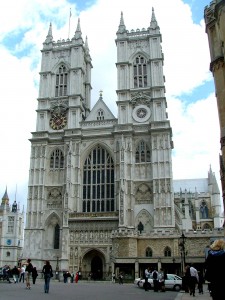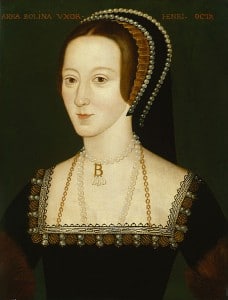
The following text is a contemporary account from The noble tryumphaunt coronacyon of Quene Anne, wyfe unto the most noble kynge Henry VIII, a pamphlet printed by Wynkyn de Worde shortly after the coronation:
“The Sunday in the morning at 8 o’clock the queen’s grace with noble ladies in their robes of estate with all the nobles apparelled in parliament robes as dukes, earls, archbishops and bishops with barons and the barons of the five ports with the mayor of the city, the aldermen in their robes as mantels of scarlet. The barons of the five ports bore a rich canopy of cloth of gold with stanes [?] of gold and four belles of silver and gilt. The Abbot of Westminster in his rygals [vestments] came into the hall in pontificalibus with his monks in their best copes, the King’s chapel in their best copes with the bishops richly adorned in pontificalibus and the ray cloth blue, spread from the high desses of the king’s bench unto the high altar of Westminster.
And so every man proceeding to the minster in the best order, every man after their degree appointed to their order and office as apertaineth, came unto the place appointed where her grace received her crown with all the ceremonies therof as there unto belongeth. And so all the ceremonies done with these solemn mass, they departed home in their best orders, every man to the hall of Westminster where the queen’s grace withdrew herself for a time into her chamber appointed and so after a certain space her grace came into the hall. Then ye should have seen every noble man doing their service to them appointed in the best manner it hath been seen in any such ceremony.
 The queen’s grace washed, the Archbishop of Canterbury said Grace. Then the nobles were set to the table, therewith came the queen’s service, with the service of the archbishop a certain space, three men with the queen’s grace service. Before the said service came the Duke of Suffolk, High Constable that day and Steward of the feast, on horseback and marvellously trapped in apparel with riches. Then with him came the Lord William Howard, as deputy to the Duke of Norfolk in the role of the Marshal of England, on horseback. The Earl of Essex carver. The Earl of Sussex sewer. The Earl of Derby cupbearer. The Earl of Arundel butler. The Viscount Lisle panter. The Lord Bray almoner. These noble men did their service in such humble sort and fashion that it was a wonder to see the pain and diligence of them being such noble personages.
The queen’s grace washed, the Archbishop of Canterbury said Grace. Then the nobles were set to the table, therewith came the queen’s service, with the service of the archbishop a certain space, three men with the queen’s grace service. Before the said service came the Duke of Suffolk, High Constable that day and Steward of the feast, on horseback and marvellously trapped in apparel with riches. Then with him came the Lord William Howard, as deputy to the Duke of Norfolk in the role of the Marshal of England, on horseback. The Earl of Essex carver. The Earl of Sussex sewer. The Earl of Derby cupbearer. The Earl of Arundel butler. The Viscount Lisle panter. The Lord Bray almoner. These noble men did their service in such humble sort and fashion that it was a wonder to see the pain and diligence of them being such noble personages.
The service borne by knights, which were to me to long to tell, in order the goodly service of kinds of meat with their devices from the highest unto the lowest there have not been seen more goodlier nor honourabler done in no man’s day. There were four tables in the great hall along the said hall. The noble women one table sitting all on the one side. The noble men another table. The Mayor of London another table with his brethren. the barons of the ports with the master of the chancery the fourth table. And thus all things nobly and triumphantly done at her coronation, her grace returned to Whitehall with great joy and solemnity, and the morrow was great jousts at the tilt done by 18 lords and knights where was broken many spears valiantly. But some of their horses would not come at their pleasure near unto the tilt, which was displeasure to some that there did run.”1
You can read more about the coronation ceremony itself in my article from last year – click here.
Notes and Sources
- de Worde, Wykyn The Maner of the tryumphe of Caleys and Bulleyn: and The noble tryumphaunt coronacyon of Quene Anne, wyfe unto the most noble kynge Henry VIII, printed by Wynkyn de Worde, 1532-33, edited by Edmund Goldsmid, 1884, Edinburgh, p. 33-37. I have modernised the spelling so that it’s easier to read.
The Viscount Lisle panter
What did a panter do??? My inner 12 yo is giggling at the thought of an official being able to pull down the hose of all these eminent gentlemen…
Ha! I think he was in charge of the pantry.
Were any of Henry’s other wives anointed and crowned with St. Edward’s crown as was Anne? What is the significance of this ceremony?
The only other wife to be crowned was Katherine of Aragon and IIRC she was crowned with the consorts crown since St Edward’s crown was used solely for the king .
Both Mary and Elizabeth used St Edward’s crown to show that they were both queen regnant rather than queen consort.
She was pregnant at the time so really she done well as that was a tedious ceremony, bet she was so glad when it was all over and she could collapse on her bed, she had reached the pinnacle of her career and must have felt elated but the battle wasn’t over and now she had to strive to keep a hold on the Kings affections, and bear a male heir, sadly we know she didn’t succeed in either.
What a wonderful but tiring banquet and services. I bet the sight of Charles Brandon and William Howard in their finary galloping up and down the great hall on dressed horses was very fine. Anne was heavily pregnant, this must have been tiring. Even with a rest and freshen up she must have been very hot and fed up. The food and service must have been very welcome.